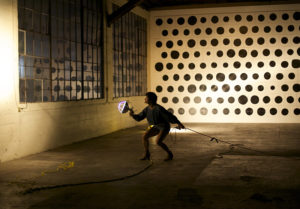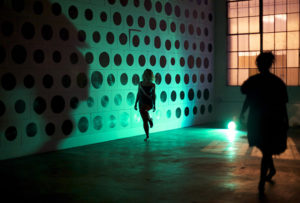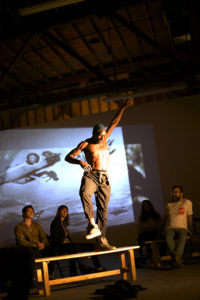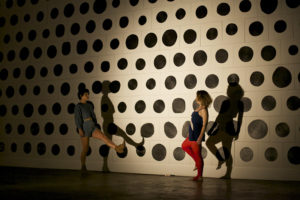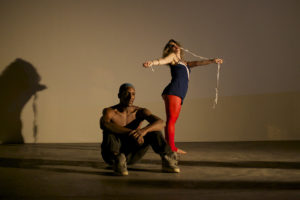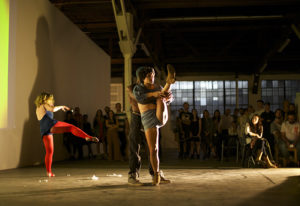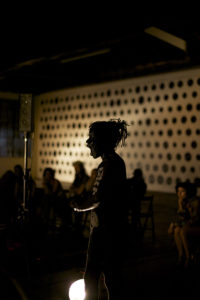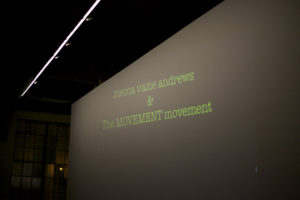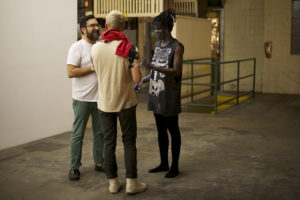Mecca Vazie Andrews & the MOVEMENT movement: Of Light and Dark: Part III The Matter of Compass
- Mecca Vazie Andrews interviewed by Dorothy Dubrule, November 2014
Dorothy Dubrule: You have described your performance practice as partnering theater, performance art, dance, and text. When you are building a single work that incorporates each of these disciplines, do you experience them as separable from one another? Do they individually carry possibilities and limitations for what they can do within a work?
Mecca Vazie Andrews: When I develop new pieces I do think of them as separate elements that speak to different sides of the idea. As for their individual capabilities, I don’t really consider limitations in my MOVEMENT movement company work. I only consider the cast, the content, and the structure. Mostly, the limitations I encounter revolve around dough, which I’m incredibly accustomed to. The cool thing about that part is it establishes a foundation of flexibility in the development of the creative poorcessing process. Which kind of leads to a “How do I figure this out then, cause I’m psyched to share stuff with others” approach. I’ve become really, really proficient at problem solving.
DD: Something that I consider to be unique to the Los Angeles dance community is the prominence of commercial dance (i.e. choreographers who work on music videos, television shows, movies, etc). As a choreographer who is signed with a talent agency and who produces work both in commercial and concert settings, how do you navigate between the traditions and values of these (potentially) opposing worlds?
MVA: In 2007, when I decided I wanted to develop my own work, I considered commercial dance an appropriate and necessary creative platform that sometimes speaks directly to my positive and negative experiences in the commercial world and otherwise. I enjoy both circumstances greatly, however, commercially I made a choice to involve myself in work that supports my MOVEMENT movement mission and have been really lucky to work with others of the same mindset. In 20 years dancing professionally, I’ve only had one experience where I had to remove myself from the situation. I was cast in a reality television show that attempted to pit the female cast members against on another. I left when they took us to a plastic surgeon who began writing on the women’s bodies and commenting on the parts they should “fix”. At which point I said my part, thanked them for their time, and said peace, catch you on the flip side. In commercial work one finds limitations because one is working within a collaborative structure where each individual’s role in the process is pre-determined. In my company, the roles shift amongst the radicals I work with.
I’ve sat many times in my youth and adulthood, with mentors and by myself, grappling with, pondering, and assessing how things function in the world and how I can kindly impress upon my students, peers, and strangers the importance of diversifying one’s perceptions of others based on outside appearances. I’ve come to the conclusion that it’s super important to involve myself in commercial work to try my best to affect change inside out in this regard. Book neh judge cover type fing.
DD: The dances that you make are both site and audience responsive. At what point do these considerations enter your process?
MVA: When developing work I instinctually can’t separate where it will be performed and how that might inform the piece differently. Walls, architecture, sky, asphalt, fine art on the wall, tagging on the wall– all these things inspire and resonate differently.
DD: The piece you will be showing at 356 on Sunday, Of Light and Dark Part III: The Matter of Compass, contains some pretty explicit political imagery. Do you find yourself referencing political identity frequently in your work, or is this impulse a response to Jonathan Horowitz’s 590 Dots, currently on view in the gallery?
MVA: Of Light and Dark III: The Matter of Compass is part of a series of pieces I’m developing that explores tenebrism on a few different levels. I’m psyched because the concept of a spectrum of light to dark connects with Mr. Jonathan Horowitz’s installation in a way that I find super interesting. His work is so beautiful. I feel it deeply. So deeply that I took my mom to draw a dot with me after I laid eyes on it. In developing my piece, I sat at 356 Mission and wrote down ideas that came to mind for a spell on a sunny afternoon. Some involved my personal politics, others didn’t. Sometimes I want to chat poli-sci, sometimes I don’t. It just depends. Life’s long, ya know. It’s necessary to keep it simple every so often so one’s brain matter doesn’t splatter and heart parts don’t erupt.
DD: Can performance go somewhere in its address of political issues that visual art can’t go?
MVA: Everything is entirely possible. I believe this strongly.
Dorothy Dubrule is a Los Angeles-based choreographer and performance scholar
- Of Light and Dark Part III: The Matter of Compass
Mecca Vazie Andrews & the MOVEMENT movement
"Of Light and Dark: Part III The Matter of Compass"
Performance y MOVEMENT movement


